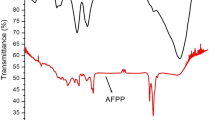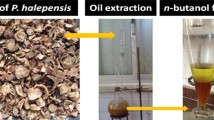Abstract
Pine needle (Pinus massoniana Lamb.) of large quantity in China and health benefit makes its application on pharmaceutical and food industry in high demand. The chemical composition of pine needle aqueous extract (PNAE) analyzed by gas chromatograph-mass spectrometry revealed that among more than 10 compounds in PNAE, organic acids were over 76.92%, with acetic acid being 25.20%, hexadecanoic acid 18.19%, and 2-methoxy-4-vinylphenol 16.44%. Ultra-performance liquid chromatography-mass spectrometry disclosed other 5 short chain organic acids, including citric acid, succinic acid, malonic acid, malic acid, and oxalic acid. The antibacterial activity of PNAE on common spoilages and pathogenic bacteria showed that the growth of Bacillus subtilis, Staphylococcus aureus, Bacillus cereus, Micrococcus luteus, Escherichia coli, and Proteus vulgaris were inhibited significantly, with minimum inhibitory concentrations and minimum bactericidal concentrations being 3.8–15 and 7.5–30 mg/mL, respectively. Our findings suggested that pine needles with effective and safe antibacterial components possess the potential to be developed into efficacious natural antiseptic products for food disinfection and medical purpose.
Similar content being viewed by others
References
Xie JJ, Zhong QP, Xu Y, She SW. Application of natural antimicrobials in food preservation. China Food Additives 1: 27–29 (2001)
You X. Food safety and food additive of antiseptic. Food Sci. Technol. 1: 1–4 (2006)
Tassou C, Koutsoumanis K, Nychas GJE. Inhibition of Salmonella enteritidis and Staphylococcus aureus in nutrient broth by mint essential oil. Food Res. Int. 33: 273–280 (2000)
Valero M, Salmeroj MC. Antibacterial activity of 11 essential oils against Bacillus cereus in tyndallized carrot broth. Int. J. Food Microbiol. 85: C73–C81 (2003)
Ros JL, Recio MC. Medicinal plants and antimicrobial activity. J. Ethnopharmacol. 100: 80–84 (2005)
Lee SH, Chang KS, Su MS, Huang YS, Jang HD. Effects of some Chinese medicinal plant extracts on five different fungi. Food Control 1: 1–8 (2007)
Feng WS, Zheng XK, Wang YZ, Bi YF, Wang XL. Isolation and structure identification of the chemical constituents from pine needles of Pinus massoniana Lamb. Nat. Prod. Res. Develop., China 16: 500–502 (2004)
Guo AW, Xiong CM, Zhou JL, Wan HL. The application of pinus needle leaves powder in the animal production. J. Southwest Forestry College, China 27: 91–93 (2007)
Koukos PK, Papadopoulou KI, Patiaka DT, Papagiannopoulos AD. Chemical composition of essential oils from needles and twigs of balkan pine (Pinus peuce Grisebach) grown in northern Greece. J. Agr. Food Chem. 48: 1266–1268 (2000)
Jeon HJ, Lee KS, Ahn YJ. Growth-inhibiting effects of constituents of Pinus densiflora leaves on human intestinal bacteria. Food Sci. Biotechnol. 10: 403–407 (2001)
Lim YS, Park KN, Bae MJ, Lee SH. Antimicrobial effects of ethanol extracts of Pinus densiflora Sieb and Zucc on lactic acid bacteria. J. Korean Soc. Food Sci. Nutr. 30: 1158–1163 (2001)
Kim YS, Shin DH. Volatile components and antibacterial effects of pine needle (Pinus densiflora S. and Z.) extracts. Food Microbiol. 22: 37–45 (2005)
Selvakumar G, Saha S, Kundu S. Inhibitory activity of pine needle tannin extracts on some agriculturally resourceful microbes. Indian J. Microbiol. 47: 267–270 (2007)
Iordache A, Culea M, Gherman C, Cozar O. Characterization of some plant extracts by GC-CMS. Nucl. Instrum. Meth. B 267: 338–342 (2009)
Apollonio LG, Pianca DJ, Whittall IR, Maher WA, Kyd JM. A demonstration of the use of ultra-performance liquid chromatographymass spectrometry (UPLC/MS) in the determination of amphetamine-type substances and ketamine for forensic and toxicological analysis. J. Chromatogr. B 836: 111–115 (2006)
Dolganiuc A, Radu LD, Olinescu A. The effect of products of plant and microbial origin on phagocytic function and on the release of oxygen free radicals by mouse peritoneal macrophages. Bacteriol. Virusol. Parazitol. Epidemiol. 42: 65–69 (1997)
José MC, José MD, Herminia D. Antioxidant and antimicrobial effects of extracts from hydrolysates of lignocellulosic materials. J. Agr. Food Chem. 49: 2459–2464 (2001)
Karaman İ, Şahin F, Güllüce M, Ö>gütçü H, Şengül M, Adıgüzel A. Antimicrobial activity of aqueous and methanol extracts of Juniperus oxycedrus L. J. Ethnopharmacol. 85: 231–235 (2003)
Zhao JP, Cui QL, Dong T, Zhang RY. Common anti-mould agents in feedstuff and their applying methods. Henan J. Husband. Vet. Med., China 8: 34 (2004)
Ji LL, Luo YM, Yan GL. Studies on the antimicrobial activities of extracts from Eupatorium lindleyanum DC against food spoilage and food-borne pathogens. Food Control 19: 995–1001 (2008)
Sofos JN, Busta FF. Antimicrobial activity of sorbate. J. Food Protect. 44: 614–622 (1981)
Brul S, Coote P. Review. Preservative agents in foods: Mode of action and microbial resistance mechanisms. Int. J. Food Microbiol. 50: 1–17 (1999)
Dibner JJ. Organic acids have several roles beyond antibiotics. Feedstuffs 10: 12–16 (2003)
Defoirdt T, Halet D, Sorgeloos P, Bossier P, Verstraete W. Short-chain fatty acids protect gnotobiotic Artemia franciscana from pathogenic Vibrio campbellii. Aquaculture 261: 804–808 (2006)
van der Wielen P, Biesterveld S, Notermans S, Hofstra H, Urlings BAP, van Knapen F. Role of volatile fatty acids in development of the cecal microflora in broiler chickens during growth. Appl. Environ. Microb. 66: 2536–2540 (2000)
Van Immerseel F, Boyen F, Gantois I, Timbermont L, Bohez L, Pasmans F, Haesebrouck F, Ducatelle R. Supplementation of coated butyric acid in the feed reduces colonization and shedding of Salmonella in poultry. Poultry Sci. 84: 1851–1856 (2005)
Vázquez JA, González MP, Murado MA. Effects of lactic acid bacteria cultures on pathogenic microbiota from fish. Aquaculture 245: 149–161 (2005)
Steele FM, McMullin DQ. The examination of surface contamination on beef carcasses during slaughter and aging in a small-scale meat packaging operation equipped with an organic acid carcass washer. J. Anim. Vet. Adv. 6: 927–931 (2007)
Van Immerseel F, Cauwerts K, Devriese LA, Haesebrouck F, Ducatelle R. Feed additives to control Salmonella in poultry. Worlds Poultry Sci. J. 58: 501–513 (2002)
Katie F, Carol P. Potential antimicrobial uses of essential oils in food: Is citrus the answer? Trends Food Sci. Tech. 19: 156–164 (2008)
Lambert RJW, Skandamis PN, Coote P, Nychas GJE. A study of the minimum inhibitory concentration and mode of action of oregano essential oils, thymol, and carvacrol. J. Appl. Microbiol. 91: 453–462 (2001)
French GL. Bactericidal agents in the treatment of MRSA infections—the potential role of daptomycin. J. Antimicrob. Chemoth. 58: 1107–1117 (2006)
Author information
Authors and Affiliations
Corresponding author
Rights and permissions
About this article
Cite this article
Feng, S., Zeng, W., Luo, F. et al. Antibacterial activity of organic acids in aqueous extracts from pine needles (Pinus massoniana Lamb.). Food Sci Biotechnol 19, 35–41 (2010). https://doi.org/10.1007/s10068-010-0005-2
Received:
Revised:
Accepted:
Published:
Issue Date:
DOI: https://doi.org/10.1007/s10068-010-0005-2




